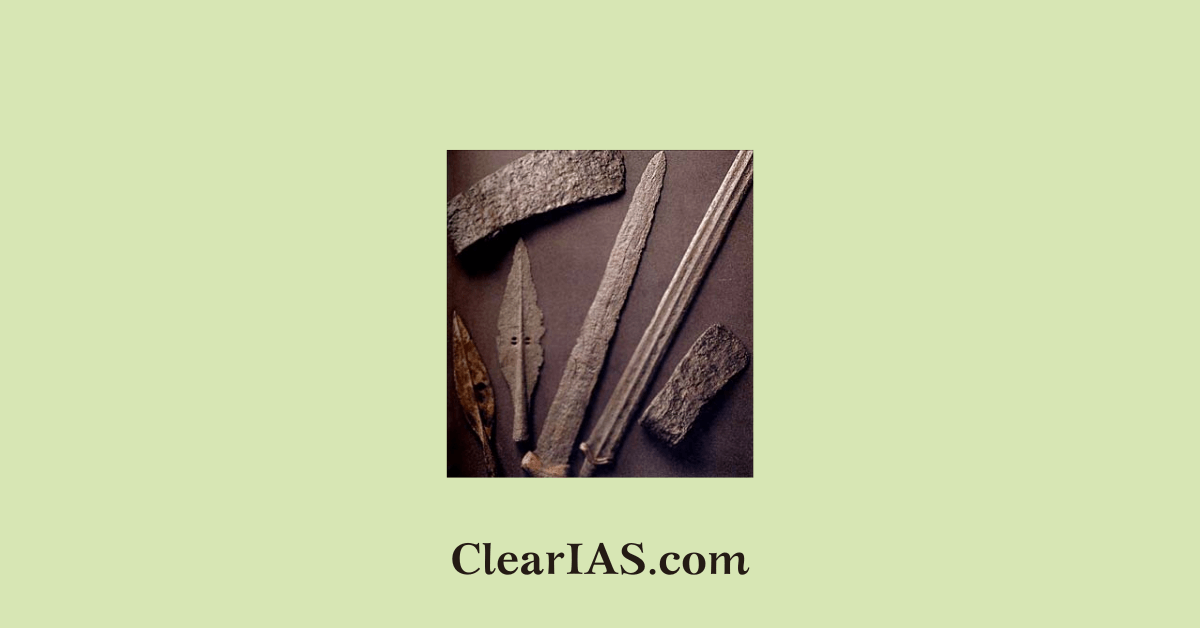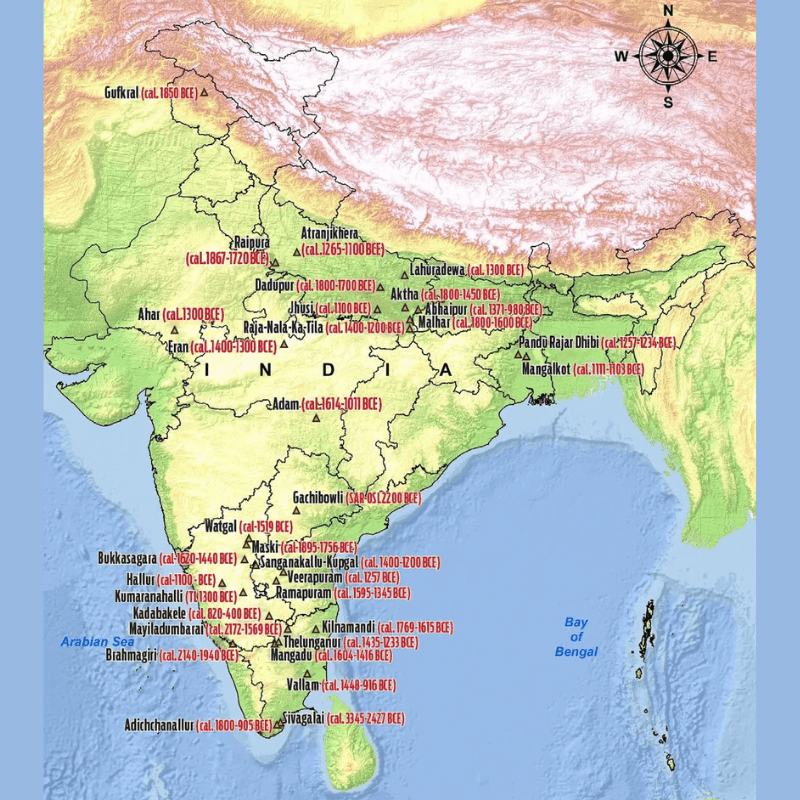
New Discoveries from Haryana & Tamil Nadu are shedding more light on the beginnings of the Iron Age in India. Read here to learn more about the prehistoric age.
The Iron Age is a prehistoric period that trailed the Bronze Age, marked by the widespread use of iron for tools, weapons, and other implements.
Globally, the Iron Age followed the Copper–Bronze Age or served as a bridge between the Bronze Age and the Early Historic period.
In India, however, the sequence is more complex and varies by region.
Bronze Age to Iron Age Transition
- Bronze Age in India: Indus Valley Civilization (3300–1300 BCE)
- Iron Age in India: Traditionally dated ~1500–600 BCE in northern India; associated with Painted Grey Ware (PGW) culture in the Gangetic plains.
- Global Context: Earlier belief — iron technology first emerged in the Hittite Empire (~1300 BCE, Anatolia, Turkey).
Iron Age in India: Overview
- Period: ~1500 BCE – 600 BCE (varies regionally)
- Earlier Sequence:
- Harappan/Bronze Age (3300–1300 BCE)
- Chalcolithic/Copper Age (after 2000 BCE in many regions)
- Iron Age (1500 BCE onwards, marked by Painted Grey Ware in the north)
- New Evidence (Tamil Nadu 2024): Pushes earliest iron use in India to ~3345–2953 BCE (Sivagalai), making it the oldest known globally.
- Technology:
- Iron production involved ore collection, smelting at ≥1200°C, and tool forging.
- Mastery over furnace temperature control was crucial.
- Textual References:
- Rigveda: Ayas refers to copper/alloys; iron is not explicitly mentioned.
- Atharvaveda: Ayas/Karshnyas specifically refers to iron; other metals mentioned include Rajata (silver), Trapu (tin), Sisa (lead).
- Early Historic Period: Ironworking appears in Buddhist texts, and Kautilya’s Arthashastra mentions widespread and strategic use.
Regional Variations

North India
- Black-and-Red Ware (BRW) Culture
- Pottery with black interiors, red exteriors via inverted firing.
- Found in Harappan (Gujarat), pre-PGW (North India), and Megalithic contexts (South India).
- Marks early Iron Age phase.
- Painted Grey Ware (PGW) Culture (c. 1200–600 BCE)
- Fine grey pottery with black geometric designs.
- Spread: Upper Ganga Valley, Haryana, Rajasthan.
- Linked with early iron tools and Mahabharata-era settlements.
- Northern Black Polished Ware (NBPW) Culture (c. 700–100 BCE)
- Highly polished, wheel-made black pottery.
- Associated with Second Urbanization, state formation, the Mauryan Empire, and the spread of Buddhism.
- Period of widespread iron technology.
South India
- Dominated by Megalithic Culture (c. 1200–300 BCE in mainstream chronology, but now possibly much earlier).
- Key Sites:
- Naikund (Vidarbha): Iron-smelting furnaces.
- Paiyampalli (Tamil Nadu): Abundant iron slag.
- Sivagalai (Tamil Nadu, 2019-22): Iron use dated to 3345-2953 BCE, the earliest globally.
- Features: Large stone burials (dolmens, cists, cairns), advanced smelting, iron agricultural tools, weapons.
Central & Eastern India
- Central India (Malwa): Sites like Nagda, Eran, Ahar (750–500 BCE) show BRW pottery with iron implements.
- Middle & Lower Ganga Valley: Sites like Pandu Rajar Dhibi, Mahisdal, Chirand, Sonpur (~750–700 BCE) mark the transition from Chalcolithic to Iron Age.
Topra Kalan (Haryana): New Evidence
Location: Yamunanagar district, Haryana
Historic Link:
- Original site of Delhi-Topra Ashokan pillar (Mauryan period, 3rd century BCE), moved to Delhi in 14th century by Firoz Shah Tughlaq.
- Documented as an important Buddhist site by Sir Alexander Cunningham and Hiuen Tsang.
Key Discoveries:
- Artifacts: Painted Grey Ware (PGW), stamped pottery, moulded bricks, beads.
- Pottery Types: Black-and-Red Ware, late Bronze Age and early Iron Age styles.
- Structures: Walls, platforms, enclosures (4–5 m depth).
- Religious Link: Dome-like structure interpreted as a Buddhist stupa.
Cultural Significance:
- Demonstrates continuity from late Harappan / Bronze Age traditions to early Iron Age in northern India.
- Links northern Iron Age cultures (PGW) with early Mauryan Buddhist activity.
Tamil Nadu: Rewriting Global Iron Age Chronology
Study: Antiquity of Iron: Recent Radiometric Dates from Tamil Nadu (TN State Archaeology Dept., ASI, universities).
Dating Techniques:
- Accelerator Mass Spectrometry Radiocarbon (AMS 14C)
- Optically Stimulated Luminescence (OSL)
Key Sites & Findings:
Site |
Period |
Key Finds |
Sivagalai |
3345–2953 BCE |
Iron-related artefacts; burial urn dated to 1155 BCE – oldest global iron technology evidence |
Mayiladumparai |
2172 BCE |
Iron smelting evidence |
Kilnamandi |
1692 BCE |
Earliest sarcophagus burial in Tamil Nadu |
Adichchanallur, Mangadu, Thelunganur |
Various |
Iron-smelting furnaces, advanced metallurgy evidence |
Technological Insights:
- Three distinct furnace types — capable of 1,300°C, enough to produce sponge iron.
- Suggests parallel development:
- North of Vindhyas: Copper Age still ongoing.
- South of Vindhyas: The Iron Age was underway due to limited copper availability.
Implications for Indian & Global History
- Oldest Iron Age globally, which pushes back human mastery of high-temperature metallurgy by over a millennium.
- Challenging Eurocentric narratives disproves the idea that iron technology diffused from the Near East to India.
- Cultural Continuity & Regional Diversities: Simultaneous but regionally distinct technological phases.
- Socio-economic Impact:
- Stronger tools- agricultural intensification.
- Iron weapons – fortified polities, warrior cultures.
Other key facts about Iron Age
- Painted Grey Ware (PGW): Associated with the early Iron Age Ganga-Yamuna Doab.
- AMS Radiocarbon Dating: Measures carbon isotopes for precise dating of organic materials.
- OSL Dating: Dates the last exposure of sediments to sunlight.
- Topra Kalan: Ashokan pillar site, Buddhist heritage.
- Sivagalai: Oldest known iron use in the world.
Practice Questions
- Essay: “Rewriting the Iron Age: Indigenous Innovation and the Question of Diffusion.”
- GS I: “Discuss how recent archaeological findings from Tamil Nadu challenge established narratives of the Iron Age in India.”
Related articles:







Leave a Reply